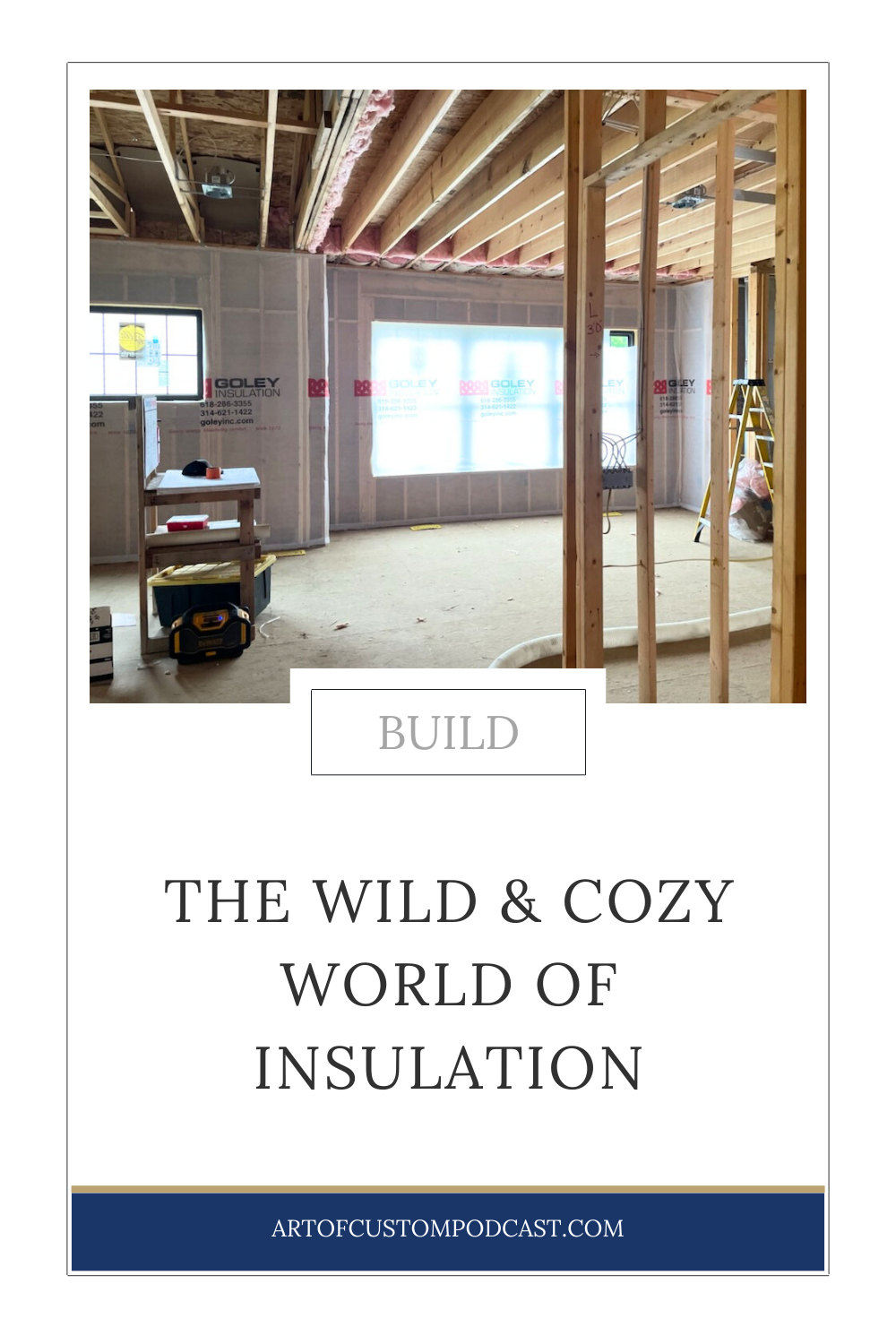The Wild & Cozy World of Home Insulation Packages
When building a high-performance home, it's what is on the inside that counts the most. In this episode of The Art of Custom, we take a deep dive into one of the most critical aspects of energy-efficient building - insulation.
Building an insulation package that makes your home more comfortable, efficient, and healthier to live in begins with making informed decisions about what insulation options are available on the market today and what works best for your project.
We brought in Mike Pruitt from Goley Insulation to explore the different types of insulation products. From the pros and cons to building the right mix of products to maximize your home's performance, we explore how to make your home as efficient as it is beautiful.
You can read the transcript below, or...
Episode Tool Box:
See BIBs insulation installation in one of our custom home projects

Season Six, Episode Two | Transcript
From fiberglass and spray foam to air sealing and vapor barriers, this episode breaks down the science behind a home’s thermal envelope and helps listeners understand why insulation is the foundation of a high-performance home.
Why Insulation Matters
Insulation is what keeps your home comfortable, energy-efficient, and durable. It forms an envelope around your home and works with windows, doors, siding, and roofing to separate indoor air from outdoor conditions.
Insulation is one of the most critical components of a high-performance build because it affects every other system in the home: HVAC design, air quality, humidity, and overall comfort. A well-insulated home doesn’t just perform better, it also saves homeowners money every month.
Understanding Key Terms
Before diving into materials, Mike defines a few key industry terms:
- R-Value: Measures resistance to heat flow. The higher the R-value, the better the material insulates.
- Grade 1 Installation: Refers to insulation installed without gaps, compression, or voids and is critical to achieving full R-value performance.
- Thermal Bridging: When framing or materials conduct heat through the wall, reducing total insulation performance.
Custom vs. Production Homes: Insulation Differences
Production homes typically use basic fiberglass batts installed quickly to meet code minimums. Semi-custom and custom builders, however, focus on insulation performance and selecting the right materials for each area of the home to ensure proper air sealing.
Custom builders like Hibbs Homes also educate clients on the options, value, and long-term payback of different insulation products so homeowners can invest strategically in upgrades that improve comfort and efficiency.
Fiberglass & Blown-In Systems
Fiberglass insulation is the industry standard and, when installed correctly, performs well at a reasonable cost. However, custom builders often prefer Blown-In Blanket System (BIBS), which fills wall cavities completely, eliminating air gaps and achieving consistent R-values.
The BIBS method:
- Uses a mesh system that holds blown-in fiberglass in place.
- Creates uniform density and coverage behind wires and outlets.
- Reduces noise transfer and drafts compared to batts.
The result is a quieter, more efficient home.
Spray Foam: Ultimate Air Sealing
Spray foam insulation is known as the ideal option for air-sealing. It fills the cracks and gaps where walls meet floors or ceilings where air typically leaks and energy is wasted.
Benefits of spray foam:
- Excellent for sealing rim joists, attics, and floors above garages.
- Reduces drafts and energy loss.
- Acts as both insulation and a vapor barrier in many climates.
Drawbacks of spray foam:
- Higher cost compared to other materials.
- Can be overkill for entire wall systems when other cost-effective options exist.
High-performance builders typically use hybrid systems such as a thin, flash-coat of foam for air sealing, followed by blown-in insulation for maximum efficiency without the cost of full foam.
Moisture Control & Vapor Barriers
Moisture management is as important as temperature control. In mixed climates like St. Louis, vapor barriers can actually trap moisture and cause problems like mold or wall damage.
Homes need to "dry both ways," letting walls breathe to the interior and exterior. The right approach to moisture management depends on your climate:
- Cold Regions: Typically require vapor barriers on the warm side.
- Hot, Humid Climates: Use different layers to prevent condensation.
- Mixed Climates: Often rely on vapor-permeable systems rather than full barriers.
As we like to say, "Build it tight, ventilate it right."
The Thermal Envelope & Air Sealing
A home’s thermal envelope includes every surface that separates conditioned interior spaces from the outside: walls, floors, ceilings, doors, and windows.
Insulation alone isn’t enough. Air sealing is essential to preventing leaks and maintaining stable indoor temperatures.
Caulk, spray foam, and drywall gaskets should be used to seal gaps around framing, windows, and top plates. This not only saves energy but makes homes quieter and more comfortable.
Raised-Heel Trusses & Framing Details
The framing of a high-performance home needs certain design details to improve insulation performance. For example:
- Raised-Heel Trusses: Add space above exterior walls, allowing insulation to extend fully over the top plate to eliminate areas where heat loss commonly occurs.
- California Corners & Ladder Framing: Create cavities in framing corners and wall intersections so insulation can reach every nook.
These simple adjustments during design dramatically improve a home’s energy performance without major added cost.
Soundproofing for Comfort
Insulation isn’t just about temperature, it also affects acoustics. Sound batts around bathrooms, laundry rooms, media spaces, and between floors is of the most cost-effective comfort upgrades a homeowner can make during construction.
Soundproofing also improves privacy in multi-generational homes or open-concept layouts, which makes a custom home feel even more tailored to how families live.
Insulation by Zone & Climate
Insulation strategies vary by region. The U.S. is divided into climate zones, and each requires different R-values and materials for optimal performance.
Homeowners should always consult their builder and insulation contractor to choose products suited to local conditions. For example, what works in Utah’s dry mountain climate may not perform well in Missouri’s humid summers.
Cost vs. Value
Upgrading insulation is a balance between cost and comfort. Spending an extra $5,000–$7,000 on insulation and air sealing can reduce monthly heating and cooling bills for decades.
When paired with quality windows and HVAC systems, better insulation increases energy efficiency, resale value, and everyday comfort, which truly pays for itself over time.
Insulation may not be glamorous, but it is the foundation of every high-performance home. By understanding R-values, materials, and the importance of air sealing, homeowners can make smarter decisions that improve comfort, efficiency, and durability for years to come.
For more information visit www.artofcustompodcast.com or find us on Facebook and Linkedin as The Art of Custom. Be sure to subscribe to get the latest episodes and please rate and review, The Art of Custom is produced by Hug Monster with original music by Adam Frick-Verdine. Thanks for listening.

